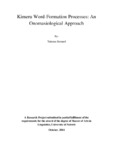| dc.description.abstract | This research project focuses on the Kimeru word
-
formation processes
within
an
onomasiological
theoretical framework.
It
endeavours t
o
:
identify the word
-
formation
processes in Kimeru Language;
investigate to what extent the individual word
-
formation rules or processes in Kimeru can be productive;
find out whether there are
productive syntactically
-
based word
-
formation proce
sses in Kimeru; and
account for
the research data using an onomasiological theory of word
-
formation.
To these ends,
an appropriate methodol
ogy was adopted: P
urposive sampling was used to select a
representative sample of ten informants,
while carefully dra
wing two informants from
each
of the five village
s covering our area of research.
The se
le
cted informants were
then used to a
ssist in the generation of data
and in
counter
-
checking the data given by
each other to ensure correctness and authenticity
,
as wel
l as
in
the pronunciation of
both the words and the affixes in the data during participant observation sessions. The
rest of the data was generated t
hrough the introspective method.
The collected data
was
then written
down,
transcribed, classified, tabulat
ed and analysed
morphologically. In the process, intuitions were also made, on the basis of native
-
speaker knowledge, about the structure of Kimeru words as well as about the
correctness of the new word coinages. Thereafter, an attempt was made to explain
the
data from an onomasiological
theoretical
angle.
After the analysis of the r
esearch
data, it was found out
that four
different
kinds of onomasiological str
uctures are
employed
by Kimeru speakers to generate new naming units,
and
that
the specific
onomas
iological structure (onomasiological type
) employed in each case depends
on
the conceptual
-
semantic field to
which the NU to be coined will
belong
as well as the
pre
-
requisite conceptual analysis
of the “object” to be named. Those On
omasiological
Types (OT
s) form
the bases for the more specific Word
-
Formation Rules (WFRs) that
ope
rate
within specific
conceptual
-
semantic fields in the process of coining new NUs
in the res
pective fields as the need arises
. T
he Onomasiological Types (OTs)
identified were OT I,
OT II, OT III an
d OT IV, and they were found to
complement
each other in clusters that proved to b
e 100% productive
and regular
within their
respective fields of operation.
Furthermore, the findings point
to
the presence of some
syntactically
-
based word
-
f
ormation processes
in Kimeru, which appear to be
productive though yielding irregular structures. | en_US |

